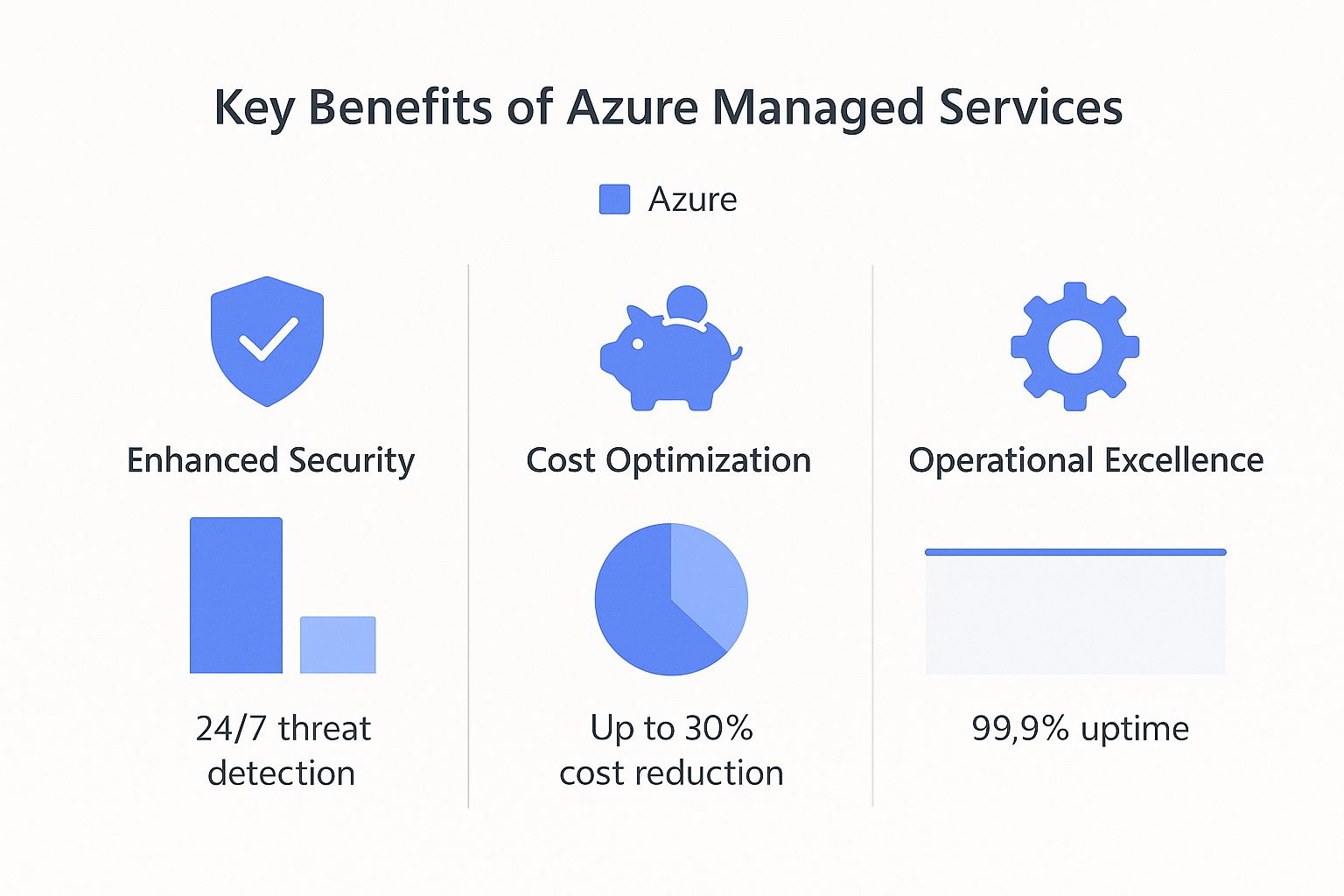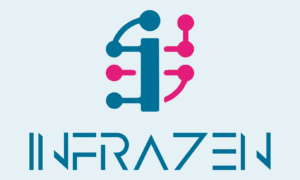Think of your Azure cloud setup as a high-performance race car. Sure, you could try to be the mechanic, engineer, and driver all at once, but wouldn't it be better to have a professional pit crew?
Azure managed services are that expert pit crew-a dedicated team that handles the complex, day-to-day operations of your cloud infrastructure so you don’t have to.
What Are Azure Managed Services

This isn’t just about outsourcing a few tasks. It's about bringing in proactive expertise to keep your environment running at peak performance, ensuring everything from security and monitoring to cost optimisation and compliance is handled with precision.
This approach frees your internal teams from the weeds of infrastructure management, letting them focus on what they do best.
Shifting Focus From Maintenance To Innovation
The main goal here is to let your skilled people get back to creating value and driving your business forward. When you hand off the operational heavy lifting to specialists, your cloud investment stops being a technical headache and becomes a genuine competitive advantage.
To really get it, you need to understand the split in duties between Microsoft and you, the customer. This is all laid out in the Azure Shared Responsibility Model. A managed service provider simply steps in to handle your side of that agreement, covering all the areas Microsoft's own support doesn't.
An effective managed services partnership isn’t about losing control-it’s about gaining capability. It gives your organisation specialised skills and round-the-clock vigilance that would be incredibly costly and difficult to build in-house.
The value is clear when you look at the numbers. The UK managed services market, a key driver for Azure adoption, was valued at around USD 15.35 billion in 2023. It's projected to nearly double to USD 28.29 billion by 2032, growing at a rate of 7.03% each year.
Core Functions Of Azure Managed Services
So, what does an Azure managed service provider (MSP) actually do? Their job is to make sure your cloud environment is secure, efficient, and perfectly aligned with your business goals.
The table below breaks down the key functions and what they mean for your business in practical terms.
| Core Function | What It Means For Your Business |
|---|---|
| Proactive Monitoring & Management | Issues are spotted and fixed before they affect your operations, keeping downtime to a minimum. |
| Security & Compliance | Robust security measures protect your sensitive data and ensure you meet industry regulations. |
| Cost Optimisation | Your cloud spending is constantly analysed to eliminate waste, giving you the best return on investment. |
| Backup & Disaster Recovery | Your data is protected with solid backup solutions, ensuring you can get back online quickly if something goes wrong. |
Ultimately, this partnership is designed to provide comprehensive support across the entire cloud lifecycle. You can see how this translates into real-world benefits by exploring our managed IT and cloud services.
The Strategic Pay-Off for Modern Businesses
Switching to Azure Managed Services brings business advantages that go far beyond what you'd expect from typical IT support. For UK businesses, this move is built on four pillars of value: rock-solid security, serious cost savings, smoother operations, and access to expertise that's hard to find on your own. Each one delivers tangible results that add up to a compelling return on your investment.
Think of it as a more mature way of handling your cloud setup. Instead of just reacting when things break, a managed service provider (MSP) works to prevent problems from happening in the first place. This ensures your Azure environment isn't just running-it's actively helping you hit your business goals. That proactive approach is what separates a basic support contract from a genuine strategic partnership.
The market is clearly catching on. Microsoft Azure has been rapidly gaining ground in the UK cloud market, putting serious pressure on Amazon Web Services (AWS). Data from the UK's Competition and Markets Authority (CMA) shows Azure’s market share is climbing, both in revenue and new customers. This growth is tied to higher profit margins, pointing to the deep value businesses are getting from offerings like Azure managed services. You can read more about the UK cloud market dynamics in this analysis.
Bolster Your Security and Compliance
For any modern organisation, security is simply non-negotiable. An expert MSP brings a dedicated security focus to your Azure environment, putting robust measures in place that many internal teams just don't have the time or specialised skills to maintain. This includes round-the-clock monitoring and proactive threat hunting to spot and neutralise risks before they can do any damage.
This isn't just about ticking boxes for firewalls and antivirus software. It's about building a comprehensive security posture.
- Continuous Threat Intelligence: Your provider stays one step ahead of emerging threats, constantly updating your defences with the latest intelligence.
- Identity and Access Management: Strict controls are put in place to ensure only the right people can access sensitive data and applications.
- GDPR and UK Data Protection Act Support: An MSP helps configure your Azure environment to meet strict regulatory requirements, massively reducing the risk of a costly compliance breach.
This intense focus lets you operate with confidence, knowing your critical assets are being protected by specialists whose entire job is to keep them safe.
Achieve Significant Cost Optimisation
Without careful management, cloud spending can easily spiral out of control. A common problem is waste from idle or over-provisioned resources-think virtual machines left running after a project wraps up or storage tiers that are far more expensive than necessary. An Azure MSP actively hunts for these inefficiencies.
By continuously analysing your usage patterns, a skilled partner can identify and eliminate wasted spend, often reducing monthly Azure bills by a significant margin. This isn't a one-time fix but an ongoing process of financial governance.
This recovered budget isn't just a saving; it's capital you can redirect from operational overheads straight into innovation. Instead of paying for cloud resources you aren’t even using, you can fund new projects, hire creative talent, or invest in technology that actually drives growth. You can explore a deeper dive into the benefits of managed IT services in our detailed guide.
Drive Operational Excellence and Efficiency
Operational excellence means your technology just works-reliably, consistently, and without any drama. Azure managed services make this happen by introducing proven processes for everything from system updates and patching to backup and disaster recovery. This structured approach minimises the risk of human error and ensures your infrastructure is resilient.
The result is higher uptime and better performance for your applications. For creative agencies, that could mean faster rendering times for huge media files or uninterrupted access to collaboration tools during a critical client pitch. For consultants, it means reliable access to client data, no matter where they are.
Ultimately, this operational stability frees your team from constantly firefighting IT issues. Instead of being pulled away to fix unexpected problems, they can stay focused on their core responsibilities, boosting productivity and making sure project deadlines are met.
Key Components of a Robust Azure Partnership
Choosing a partner for your Azure managed services isn't just about outsourcing IT tasks-it's about finding a co-pilot for your cloud journey. A genuine partnership goes way beyond basic support, offering a set of core components that actively protect, optimise, and align your Azure environment with your business goals.
Knowing what to look for is the first step in telling a simple service provider apart from a true strategic ally.
To get this right, it's crucial to pick a provider with deep expertise in offering top system integration services. This ensures your cloud environment works seamlessly with your existing infrastructure, not against it. Without solid integration, you risk creating isolated tech silos that just get in the way.
The infographic below shows the direct benefits a well-structured partnership delivers, focusing on security, cost savings, and operational uptime.

As you can see, these pillars are all connected. Better security and uptime lead to smoother operations, while getting costs under control frees up resources you can put back into innovation.
24/7 Proactive Monitoring and Incident Response
The foundation of any quality managed service is constant vigilance. Proactive monitoring means using intelligent tools to keep an eye on your Azure environment around the clock. The goal is to spot potential issues-like performance dips or unusual activity-before they blow up into service-disrupting incidents.
Think of it like a high-tech security system for your house. It doesn't just blare an alarm after a break-in; it alerts you the moment a window is tampered with, giving you time to act before any real damage is done. In the same way, a skilled partner catches early warning signs and fixes them, often without your team ever knowing there was a problem. This is what prevents costly downtime and keeps your business running smoothly.
Advanced Security Management
A strong partner delivers a multi-layered security strategy that goes far beyond ticking the default boxes. This involves expertly configuring and managing advanced security tools within Azure, like Microsoft Sentinel for threat detection and Microsoft Defender for Cloud to harden your infrastructure against attacks.
Key security management activities include:
- Continuous Vulnerability Scanning to find and patch weaknesses in your systems before they can be exploited.
- Identity and Access Control to enforce the principle of least privilege, making sure users only have access to what they absolutely need to do their jobs.
- Compliance Management to configure your environment according to specific UK regulations like GDPR, helping you avoid hefty penalties.
This dedicated focus ensures your data and applications are properly protected against ever-changing threats.
Reliable Backup and Disaster Recovery
What would happen if your critical data suddenly vanished due to a system failure or a cyber-attack? A solid backup and disaster recovery (DR) plan is your insurance policy against that nightmare scenario. A competent managed service provider doesn't just switch on backups-they design and rigorously test a comprehensive recovery strategy.
This means setting clear Recovery Time Objectives (RTOs) and Recovery Point Objectives (RPOs) to define exactly how quickly your systems must be back online and how much data loss is acceptable. They then implement solutions like Azure Site Recovery to make sure those targets are met, regularly testing the plan to guarantee it actually works when you need it most.
A backup plan that is never tested is not a plan-it's a guess. A reliable Azure partner turns that guess into a certainty, ensuring your business can withstand unforeseen events without significant interruption.
Continuous Performance and Cost Optimisation
A truly valuable partnership extends into strategic oversight, where your provider is always looking for ways to improve your environment's efficiency and financial return. This is where the role of a virtual Chief Information Officer (vCIO) often comes in, providing high-level guidance without the overhead of a full-time executive. If you're curious about this function, you can learn more about the role of the vCIO in modern MSPs and the strategic value it drives.
This optimisation work is a continuous cycle. It involves analysing resource usage to "right-size" virtual machines, spotting unused assets that can be shut down, and applying cost-saving tools like Azure Reservations. This proactive management makes sure you only pay for what you need, maximising every pound of your cloud investment.
How Managed Services Fuel Creative Innovation

For any creative organisation, technology should be an accelerator, not an anchor. But too often, teams get bogged down by the sheer grind of infrastructure management-patching servers, fixing network glitches, or just worrying about data security. Their focus is pulled away from the work that actually matters.
This is exactly where Azure managed services step in, acting as a catalyst for creative output.
When you offload the day-to-day operational weight of the cloud to an expert partner, you create breathing room for innovation. Your talented people are liberated from reactive firefighting and can pour their energy into building brilliant client experiences. The cloud stops being a chore and finally becomes the strategic asset it was always meant to be.
The entire conversation changes. Instead of wondering if the infrastructure can handle a demanding new project, you start asking what amazing things you can build on a stable, secure, and high-performing platform.
From Infrastructure Headaches to Creative Freedom
Think about a modern media company producing high-resolution video content. Their rendering workloads are enormous and swing wildly depending on project deadlines. Trying to manage the virtual machines for this in-house would be a constant, complex juggling act of scaling resources up and down.
With Azure managed services, that entire headache just disappears. The provider ensures the necessary rendering power is always available on demand, flawlessly optimised for both performance and cost. The creative team simply gets on with using their tools, confident that the tech behind them won't miss a beat. They can focus on artistic direction, not server configurations.
That freedom lets them experiment more and deliver higher-quality work faster, knowing the technical foundation is rock-solid.
Securing Collaboration for Sensitive Projects
Now, imagine a design agency collaborating with a major client on a confidential product launch. They need a secure, shared workspace where teams can pass around sensitive files without the fear of a data breach. Setting up and managing that environment with the right access controls and threat monitoring is a full-time job in itself.
A managed service provider delivers this secure collaboration space as a complete, ready-to-go solution.
- Robust Access Controls: They implement and enforce strict permissions, making sure only authorised people can see or edit sensitive client work.
- Proactive Threat Monitoring: The environment is watched 24/7 for any suspicious activity, neutralising potential threats before they can cause any real harm.
- Data Protection: Reliable backup and recovery protocols are put in place, safeguarding valuable intellectual property against accidental loss or corruption.
This allows the agency to collaborate with clients and partners confidently, knowing their most valuable work is protected by experts. The stability of a managed platform is a cornerstone of unleashing creativity with better IT processes, because it removes the friction and worry that so often stifles new ideas.
When your technology just works, reliably and securely in the background, it becomes invisible. This invisibility is the ultimate goal, as it allows creative vision to take centre stage without technical distractions.
Ultimately, an Azure managed service provider delivers the dependable platform that creativity needs to thrive. It’s a partnership that helps organisations stop spending their energy on the cloud and start building their future in it.
What Does the Journey to Azure Managed Services Look Like?
Stepping into a partnership with an Azure managed service provider isn't like flipping a switch. It’s a structured journey, designed to build trust and make sure the final setup is a perfect fit for your business goals. The whole point is to demystify the tech and tackle common worries, like the fear of losing control, right from the start.
A good partnership is built on collaboration and clear reporting, not on handing over the keys and hoping for the best. Let’s walk through the key phases that give business leaders the clarity and confidence they need to make the move.
Phase 1: Assessment and Discovery
First things first, we need to understand your world. A potential partner will sit down with your team to get a complete picture of your current IT environment, what you’re trying to achieve, and where the pain points are. This isn't just a technical audit; it's a strategic conversation.
We’re looking to answer questions like:
- What are the main business reasons for moving to the cloud or wanting to improve what you already have?
- What are your biggest operational headaches or security worries right now?
- Which apps are absolutely critical to your daily work, and what do they need to perform at their best?
This discovery stage ensures the provider knows exactly what success looks like for you. It's the foundation for everything that follows.
Phase 2: Strategy and Design
Once there’s a clear picture of your needs, the next step is to build the plan. This is where your business goals get translated into a technical strategy. Your provider will design a solution architecture that’s secure, scalable, and cost-effective, laying out a detailed roadmap for how to get there.
This plan covers everything-from the security policies that will be put in place to the backup schedules that will protect your data. Think of it as a blueprint for the partnership, defining the service level agreements (SLAs) and key performance indicators (KPIs) that will measure success. It’s a collaborative document, so you have full visibility and can give your input before any technical work kicks off.
Phase 3: Migration and Onboarding
With the strategy signed off, it’s time for the technical heavy lifting. This phase involves carefully migrating your workloads to the new Azure environment or smoothly onboarding your existing setup into the provider’s management systems. Their engineers handle the tricky bits, making sure there's as little disruption to your daily operations as possible.
A common fear is that migration will be chaotic and full of unexpected downtime. A skilled provider sidesteps this risk with meticulous planning, phased rollouts, and constant communication, ensuring the transition is smooth and predictable.
Your team is kept in the loop the entire time. The provider sets up monitoring tools, configures security agents, and integrates their support systems with yours. This is the moment your environment officially comes under their expert care.
Phase 4: Continuous Optimisation
The journey doesn't stop once you're onboarded-it just evolves. This final phase is a continuous cycle of monitoring, managing, and optimising. This is the real heart of what Azure managed services deliver. Your provider will proactively manage the environment, tweaking performance, patching systems, and hunting for ways to save you money.
Regular reports and strategic reviews keep you in the picture, offering insights into your environment's health and flagging opportunities for improvement. This ongoing partnership makes sure your cloud platform doesn't just run; it adapts and gets better over time, constantly delivering value back to your business.
InfraZen's Custom-Built Azure Managed Services

Knowing what Azure managed services are is one thing. Making them work for a creative business is a completely different challenge. Too many IT providers roll out a generic, one-size-fits-all package that completely misses the mark for creative and technical teams.
This cookie-cutter approach often leaves you paying for resources you never use or, worse, stuck with a system that just doesn't fit your workflow. At InfraZen, we simply don’t work that way. We believe real value comes from a service built around your unique operational rhythm.
The UK's Azure ecosystem is vast, built on a portfolio of over 41,000 products. With the public cloud market projected to hit £59 billion by 2024, navigating it all requires a steady hand. Sure, Azure is trusted by 85% of Fortune 500 companies, but its power has to be harnessed correctly to benefit smaller, specialised businesses like yours. You can dig deeper into Azure's UK market position and trends here.
Our Core Commitments
Our approach isn’t just about management-it’s about partnership. We’ve built our service around three key pillars that deliver genuine results for your creative business.
- A Proactive Mindset: We don't sit around waiting for things to break. Our team is constantly looking for ways to improve performance and trim costs, ensuring your Azure environment is always running at its absolute best.
- Deep Industry Expertise: We get it. We understand the unique pressures of creative workflows, from secure client collaboration to managing resource-hungry rendering tasks. Our solutions are designed to support how you actually work.
- Dedicated UK-Based Support: When you need help, you talk to an expert who knows your setup inside and out. No call centres, no scripts-just direct, responsive support from our team.
An off-the-shelf cloud service is like an ill-fitting suit-it might cover the basics, but it won't perform when it matters. Our approach is bespoke tailoring, ensuring every component of your Azure environment is perfectly aligned to your business objectives.
This commitment turns your Azure investment from a simple running cost into a real strategic asset. By taking the complexities of cloud infrastructure off your plate, we free you up to focus entirely on your core mission: delivering incredible creative work and growing your business. We provide the stable, secure, and optimised platform that lets your innovation thrive.
Still Have Questions?
Deciding to bring in a partner to manage your Azure environment is a big step, so it’s natural to have a few questions. Here are some straightforward answers to the things business leaders ask us most often.
How Much Control Do We Actually Keep?
This is usually the first question on everyone's mind, and it's a good one. The idea of handing over the keys can feel unsettling.
But a good managed service partnership isn't about giving up control-it's about delegating the day-to-day operational grind. You still own the environment, your data, and the overall strategy. We just handle the technical heavy lifting. Think of it as a collaboration: you set the direction, and we make sure the engine runs smoothly, with complete transparency and access for you at all times.
What Does a Typical Pricing Model Look Like?
Pricing for Azure managed services varies, but most credible providers stick to a few common models to keep things predictable.
The most popular is a fixed-fee monthly subscription. This is great for budgeting because you know exactly what you're paying. The fee is usually based on the size and complexity of your Azure setup-things like the number of virtual machines, databases, and storage accounts we’re looking after.
Other models you might see include:
- Per-Device or Per-User Pricing: A simple model where you pay a set price for each device or user being managed.
- Tiered Packages: Providers might offer different service levels (like basic, advanced, or premium) with different features and support levels.
The goal is to find a provider with a clear, all-inclusive model that fits what you need, so you aren't hit with unexpected costs down the line.
How Do You Handle Our Industry-Specific Compliance?
For many businesses, especially those in regulated sectors, security and compliance are non-negotiable. A specialised provider won't just apply a generic security template; they’ll dive deep into your specific requirements, whether that's GDPR, PCI DSS, or other industry standards.
The process usually involves:
- An Initial Audit: First, we assess your current setup against the compliance benchmarks you need to meet.
- Configuration Hardening: Next, we implement the necessary security controls and access policies your industry demands, using Azure’s own governance tools.
- Continuous Monitoring: We then actively monitor for any "compliance drift" and generate the reports you need for audits.
This approach turns compliance from a recurring headache into a managed, ongoing process that just happens in the background.
A partner with genuine expertise in your sector understands the specific nuances of your compliance requirements. They don’t just tick boxes; they build a robust framework that addresses your unique risks head-on.
What’s the Onboarding Process and How Long Does It Take?
A smooth transition is everything, so the onboarding journey is always a clearly defined, multi-stage process designed to cause minimal disruption. It typically kicks off with an in-depth discovery phase where we get to know your environment and business goals. This usually takes a week or two.
After that, we create a detailed migration and implementation plan. The actual onboarding can take anywhere from a few weeks to a couple of months, depending entirely on the complexity of your current infrastructure. A good provider will give you a clear, realistic timeline right from the start and keep you in the loop every step of the way.
Ready to turn your Azure environment from a complex operational burden into a real strategic asset? At InfraZen Ltd, we deliver specialised Azure managed services designed for creative organisations, ensuring your tech is secure, optimised, and perfectly aligned with your business goals.
Find out how we can help by exploring our services at infrazen.tech.

